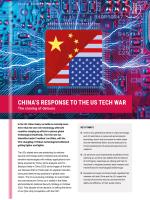China's response to the US tech war

- China is two generations behind in chips technology, and US restrictions on advanced semiconductor technology export and its success to make Japan and the Netherlands follow suit are destructive to China’s development of advanced equipment and weapons.
- US sanctions could inadvertently accelerate China’s catching up, as China has realised that the detours of contingency responses are closing and that it’s important to integrate domestic basic research and market forces for technological breakthrough.
- European and Asian countries should negotiate their interests with both China and the US, inspect the concept of economic security, and examine the safety and efficiency of their supply chains.
In the US-China rivalry, no battle is currently more fierce than the one over technology, with both countries ramping up efforts to pursue global technological leadership. The tech war has intensified under President Joe Biden, with the US’s strangling of China’s technological bottleneck getting tighter and tighter. The US’s stated aims are protecting its national security and foreign policy interests and preventing sensitive technologies with military applications from being acquired by China.
Some analysts point to Beijing’s Made in China 2025 as the trigger of the tech war because that is China’s plan to upgrade manufacturing and seek the top positions in global value chains. The US is pursuing a strategy to outcompete and outmanoeuvre China, as is stated in the Biden administration’s National Security Strategy in October 2022: “this decade will be decisive, in setting the terms of our [the US’s] competition with the PRC”.
Especially in the sector of semiconductors or chips, where the West controls China’s access to the most advanced technology, US restrictions and its ability to bring its allies into line have been destructive to China’s development. On 21 May 2023, Beijing’s ban of American chipmaker Micron from critical information infrastructure in China signals a first direct retaliation from Beijing. China has also realised that some of its hitherto measures—turning to alternative sources of import, utilising policy loopholes, and sufficing with lower-level technology—are just detours. They are not long-term solutions; nor can they be the foundation of China’s national security. The US restrictions have forced China to adopt new measures to accelerate domestic innovation with more focus on basic research and market forces.
How the tech war will play out has important implications for Western countries and global supply chains. This policy brief will focus on China’s responses to the US-waged tech war, specifically: What have been China’s domestic measures to respond to the tech restrictions from the US, and what is China’s potential for technological breakthrough? What have been China’s international responses, and what are China’s options for retaliation?
China’s domestic contingency responses
China is estimated by industry experts to be at least five years behind in making the most advanced logic chips, and even more backward—around ten years—in developing the tools and software for making chips. China can produce 14 nm chips at scale, which are mostly used in consumer electronics, cars, artificial intelligence (AI) and application processors. But China still needs more advanced technology (7nm and smaller). In 2022, China reportedly made breakthrough in making chips with a 7nm process, still two steps behind the most advanced 5nm and 3nm processes in Taiwan and South Korea. Because of its reliance on hardware from the US and its allies for the most advanced chips and semiconductor equipment, China is worried about supply chain vulnerability and its technological development for civil and military usages. Like the US, Beijing is also concerned about national security: there is a risk that the US can tap into Chinese networks through backdoors installed in the chips.
Domestically, China has tried the following contingency responses.
1. Alternative sources of import
One domestic response in China was to turn to alternative sources of import. As US export restrictions tightened, Chinese chip companies relied on costly equipment made by Japanese and Dutch companies, but the latter two are now also planning restrictions. If the restrictions include servicing, Chinese companies would not be able to use their existing imported machines.
Trump’s Huawei ban reduced Taiwan Semiconductor Manufacturing Company (TSMC)’s export reliance on China from 20% in 2020 to 10% in 2021, but China still relies on Taiwan for the most advanced chips. More than one third of China’s semiconductor imports came from Taiwan in 2021, and China relies on Taiwan for the most advanced chips. According to the chairman of TSMC, Mark Liu, the company will not be operable under an embargo by China because of the company’s need for real-time connection with international partners. The so-called Silicon Shield theory – that Taiwan’s indispensable role in the global chips value chain and its importance to the mainland would deter Beijing from forcible takeover – is being hotly debated. No matter what, to ensure that China’s plan to reunite Taiwan would not be too destructive to the mainland’s economy, China must make technological advances.
2. Loopholes in US restrictions
Another immediate response among Chinese companies has been to find loopholes in the US policies. Some Chinese companies targeted by the US sanctions have reportedly found ways to obtain restricted technology (e.g. American company Nvidia’s A100 chips) by first, using cloud providers (companies that establish public clouds, manage private clouds, or offer on-demand cloud computing services) that use A100 chips; second, rental arrangements with third parties instead of buying the chips; and third, purchasing the chips through subsidiaries in China. It should only be a matter of time before the US closes the loopholes.
3. Use of less advanced technology
A third response is to carry on with less advanced chips or machines. Chinese companies like Alibaba and Biren are reportedly modifying their semiconductors so that their contractor manufacturers like TSMC can continue to produce for them without using the banned US technology. International chips manufacturers including American Nvidia also come up with new, just-below-threshold products for the Chinese market to avoid US restrictions.
- 2020, the Trump administration banns TSMC and Samsung from manufacturing advanced chips for Chinese companies such as Huawei.
- September 2022, the Biden administration instructs American companies Nvidia Corp and Advanced Micro Devices to stop selling their graphic processing units to China.
- October 2022, exports of high-performance computing chips and semiconductor manufacturing equipment from the US to China would requires approval and all US citizens or permanent residents need to obtain permission from the US government to continue to work for Chinese semiconductor firms.
- January 2023, the US makes an agreement with Japan and the Netherlands that they will also restrict chips technology to China.
- March 2023, the US announces another wave of export bans targeting Chinese companies.
A renewed focus on domestic innovation in China
The detours that China has taken to respond to the US tech restrictions have taught China the lesson that it must resort to domestic innovation to realise semiconductor supply-chain self-sufficiency. A government official working closely with chipmakers reportedly told Financial Times: ‘China has wasted too much money on non-functional research to bypass the sanctions without harvest. It is time to ditch the delusions and channel all possible resources into the companies, with the capability to guide the industry out of misery.’
China’s support for domestic innovation has had mixed results in different sectors. When it comes to semiconductors, China has intensified state funding (including setting up a Big Fund and industry investment funds) since 2014, but with limited success because of corruption and inefficient usage of funds at local governments that set up numerous small factories. Therefore, China has adopted a new approach to supporting innovation. Instead of distributing most subsidies to local governments and state laboratories, it has realised the importance of supporting leading companies including private businesses. When the US added China’s biggest chipmaker Yangtze Memory Technologies Corp (YMTC) to the ‘Entities List’ in autumn 2022, the Chinese government reportedly poured US$7 billion investment into the company. This year, China is giving a selected group of chip companies (probably SMIC, YMTC, CXMT, Huawei, Hua Hong, NAURA, and AMEC) easier access to subsidies without performance requirements and more say over state-funded research. That does not mean the Communist Party is loosening its grip on the domestic tech sector. It set up a new Central Commission for Science and Technology, which can potently gather and coordinate resources.
China’s international responses: Options for retaliation?
In contrast to China’s retaliations to Trump’s trade war of goods, China has exhibited what tech expert Dan Wang calls ‘strategic forbearance’, even though it has at its disposal economic weapons like rare earth minerals, certain metals, supply of renewable energy equipment, and access to the Chinese market.
China brought a lawsuit at the World Trade Organization (WTO) against the US in December 2022 after Washington imposed sweeping restrictions in October. It was largely a symbolic move because the US has blocked the appointment of new judges to the WTO's Appellate Body since September 2018, thus paralysing the WTO dispute settlement system.
China has been considering countermeasures for some time. Restricting rare earths export is one of the cards that have been in domestic and international discussions. China accounts for 60% of rare earth mining and around 85% of global processing capacity, and 80% of the US’s rare earth imports come from China. Even though the US and its allies are trying to diversify their rare earths supply chains, China’s global dominance and its influence on prices will continue for a long time, probably a decade.
In May 2019, Xi Jinping visited rare earths manufacturers in Jiangxi province. After the visit, when asked whether China would use rare earths as a weapon against the US trade and tech war, the National Development and Reform Commission said: “If someone wants to use the products made with our exported rare earths to contain and suppress China's development, I think the people in the old revolutionary base area in southern Jiangxi and the Chinese people will not be happy”.
Chinese counter-sanctions
There are signs that China’s patience with the US restrictions is wearing thin. In February 2023, the Chinese government published a new Catalogue of Prohibited and Restricted Tech Export Items, which included LiDAR technology for automatic driving, photovoltaic silicon wafer technology for solar panels, and rare earth refining technology. It signals a more strategic use of China’s dominant position in some high-tech sectors for protecting itself from Western tech restrictions and for global competition.
Starting in March 2023, China has imposed new sanctions on US weapons companies Lockheed Martin and Raytheon, raided US due diligence firm Mintz, and launched an investigation into US chipmaker Micron. In particular, the opening of investigation on Micron on 1 April on national security grounds came right after the US’s latest addition of more Chinese companies to the Entity List. The decision to ban critical national infrastructure operators from buying Micron products on 21 May can be seen as China’s first direct retaliatory measure to the US-waged tech war. The choice of Micron seems still cautious because its memory chips can be easily replaced with competitors’ chips.
Potential for breakthrough?
Restrictions from the US and its allies have forced China to accelerate the innovation process by pouring more targeted resources into basic research and relying more on market forces. Chinese companies have to use and test-drive domestic chips more, which may accelerate innovation. Judging from China’s recent successes in some other technologies like lithium batteries, cloud technology and space technology, with the right kind of support from the Central Commission for the leading companies, it is likely that China can catch up with Western chip technology within a shorter timeframe than the estimated five to ten years. It took China two years to jump from the 14nm to 7nm process, faster than Taiwan and South Korea.
If China succeeds in developing chip technologies that are on par with global industry leaders, it means more competition in the global market. China’s economic scale may give it price advantage and efficiency in businesses processes and thus outcompete its Western peers in market share, as happened with solar panels and lithium batteries.
If the US and its allies continue with tech decoupling policy, Chinese and Western technology will be used in two digital worlds, increasing the transaction costs and security risks for international companies. The success of China’s semiconductor industry will depend on its domestic market and on the countries that trust Chinese technology.
If China succeeds in developing more advanced semiconductor technology than Western players or becomes the leader in next-generation transistor technology, as some Chinese scientists are advocating, China will seek to obtain global patents and copyrights that could mean bottlenecks for Western countries.
Whether or not the global digital world splits into two because of the US-China tech war, now is a strategic window where China still needs globalisation and Western technology. That gives European and Asian countries an opportunity to negotiate its interests with both China and the US, to inspect the concept of economic security, and to examine the safety and efficiency of global supply chains.
DIIS Experts



